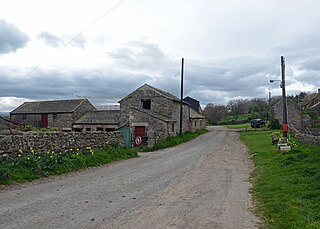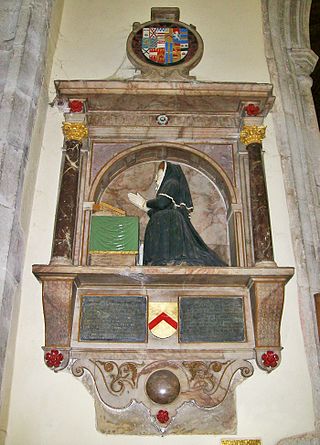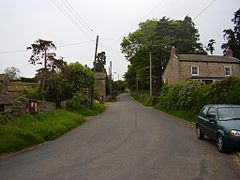
Richmond is a market town and civil parish in North Yorkshire, England. It is located at the point where Swaledale, the upper valley of the River Swale, opens into the Vale of Mowbray. The town's population at the 2011 census was 8,413. The town is 13 miles (21 km) north-west of Northallerton, the county town, and 41 miles (66 km) north-west of York.

The Keeper or Master of the Rolls and Records of the Chancery of England, known as the Master of the Rolls, is the President of the Civil Division of the Court of Appeal of England and Wales and Head of Civil Justice. As a judge, the Master of the Rolls is second in seniority in England and Wales only to the Lord Chief Justice. The position dates from at least 1286, although it is believed that the office probably existed earlier than that.
Elizabeth, Lady Coke, was an English court office holder. She served as lady-in-waiting to the queen consort of England, Anne of Denmark. She was the daughter of Thomas Cecil, 1st Earl of Exeter, and Dorothy Neville, and the granddaughter of William Cecil, 1st Baron Burghley. She was the wife of Sir William Hatton and later of Sir Edward Coke.

Bagendon is a village and civil parish in the Cotswold district of Gloucestershire, England, about four miles (6 km) north of Cirencester. According to the 2001 census it had a population of 265,decreasing to 239 at the 2011 census.

Barden is a hamlet and civil parish in North Yorkshire, England. It is about 5 miles (8 km) south of Richmond. According to the 2001 census the parish had a population of 49, remaining at less than 100 in the 2011 Census. Population information is kept in the parish of Hauxwell.

Calton is a village and civil parish in the Craven district of North Yorkshire, England, on the River Aire in Airedale. In both the 2001 and 2011 Censuses the population was less than 100, so details were included in the civil parish of Flasby with Winterburn. In 2015, North Yorkshire County Council estimated the population of the village to be 60.

Ingleby Arncliffe is a village and civil parish in North Yorkshire, England. It is situated between the A172 and A19 roads, 6.5 miles (10.5 km) north-east from Northallerton and 7 miles (11.3 km) south-east from the small market town of Stokesley, and is on the edge of the North York Moors National Park. The village is conjoined to its smaller neighbour, Ingleby Cross. Ingleby Arncliffe lies in the historic county of the North Riding of Yorkshire.

Denton is a hamlet and civil parish in the Harrogate district of North Yorkshire, England. At the 2011 Census the population of this civil parish was less than 100. Details are included in the civil parish of Middleton, Harrogate. It is situated 1 mile (1.6 km) north-east of Ilkley, West Yorkshire. Denton Hall is located in the hamlet. The church in the village is noted for some its windows which instead of stained glass, are panels where the artists have painted directly onto the glass.

Dorothy Wyndlow Pattison, better known as Sister Dora, was a 19th-century Anglican nun and nurse who worked in Walsall, Staffordshire.
Sir William Stafford, of Chebsey, in Staffordshire was an Essex landowner and the second husband of Mary Boleyn, who was the sister of Anne Boleyn and one-time mistress of King Henry VIII of England.

Elizabeth Stafford, also known as Dame Elizabeth Drury and – in the years prior to her death in 1599 – Dame (Lady) Elizabeth Scott, was a Lady of the Bedchamber to Queen Elizabeth I. She and her first husband, Sir William Drury, entertained Queen Elizabeth I at Hawstead in 1578.

The British Poet Laureate is an honorary position appointed by the monarch of the United Kingdom, currently on the advice of the prime minister. The role does not entail any specific duties, but there is an expectation that the holder will write verse for significant national occasions. The origins of the laureateship date back to 1616 when a pension was provided to Ben Jonson, but the first official holder of the position was John Dryden, appointed in 1668 by Charles II. On the death of Alfred, Lord Tennyson, who held the post between November 1850 and October 1892, there was a break of four years as a mark of respect; Tennyson's laureate poems "Ode on the Death of the Duke of Wellington" and "The Charge of the Light Brigade" were particularly cherished by the Victorian public. Three poets, Thomas Gray, Samuel Rogers and Walter Scott, turned down the laureateship. Historically appointed for an unfixed term and typically held for life, since 1999 the position has been for a term of ten years. The holder of the position as at 2024 is Simon Armitage who succeeded Carol Ann Duffy in May 2019 after 10 years in office.

Justice of the Common Pleas was a puisne judicial position within the Court of Common Pleas of England and Wales, under the Chief Justice. The Common Pleas was the primary court of common law within England and Wales, dealing with "common" pleas. It was created out of the common law jurisdiction of the Exchequer of Pleas, with splits forming during the 1190s and the division becoming formal by the beginning of the 13th century. The court became a key part of the Westminster courts, along with the Exchequer of Pleas and the Court of King's Bench, but with the Writ of Quominus and the Statute of Westminster, both tried to extend their jurisdiction into the realm of common pleas. As a result, the courts jockeyed for power. In 1828 Henry Brougham, a Member of Parliament, complained in Parliament that as long as there were three courts unevenness was inevitable, saying that "It is not in the power of the courts, even if all were monopolies and other restrictions done away, to distribute business equally, as long as suitors are left free to choose their own tribunal", and that there would always be a favourite court, which would therefore attract the best lawyers and judges and entrench its position. The outcome was the Supreme Court of Judicature Act 1873, under which all the central courts were made part of a single Supreme Court of Judicature. Eventually the government created a High Court of Justice under Lord Coleridge by an Order in Council of 16 December 1880. At this point, the Common Pleas formally ceased to exist.
English county histories, in other words historical and topographical works concerned with individual ancient counties of England, were produced by antiquarians from the late 16th century onwards. The content was variable: most focused on recording the ownership of estates and the descent of lordships of manors, thus the genealogies of county families, heraldry and other antiquarian material. In the introduction to one typical early work of this style, The Antiquities of Warwickshire published in 1656, the author William Dugdale writes:
I offer unto you my noble countriemen, as the most proper persons to whom it can be presented wherein you will see very much of your worthy ancestors, to whose memory I have erected it as a monumentall pillar and to shew in what honour they lived in those flourishing ages past. In this kind, or not much different, have divers persons in forrein parts very learnedly written; some whereof I have noted in my preface: and I could wish that there were more that would adventure in the like manner for the rest of the counties of this nation, considering how acceptable those are, which others have already performed

John James Watson (1767–1839) was an English clergyman who became prominent in the High Church group known now as the Hackney Phalanx. He became Archdeacon of St Albans in 1816.

The General View series of county surveys was an initiative of the Board of Agriculture of Great Britain, of the early 1790s. Many of these works had second editions, in the 1810s.
The Phytologist was a British botanical journal, appearing first as Phytologist: a popular botanical miscellany. It was founded in 1841 as a monthly, edited by George Luxford. Luxford died in 1854, and the title was taken over by Alexander Irvine and William Pamplin, who ran it to 1863 with subtitle "a botanical journal".
Dorothy Frances Blomfield (1858–1932) was an English hymn-writer and poet.















